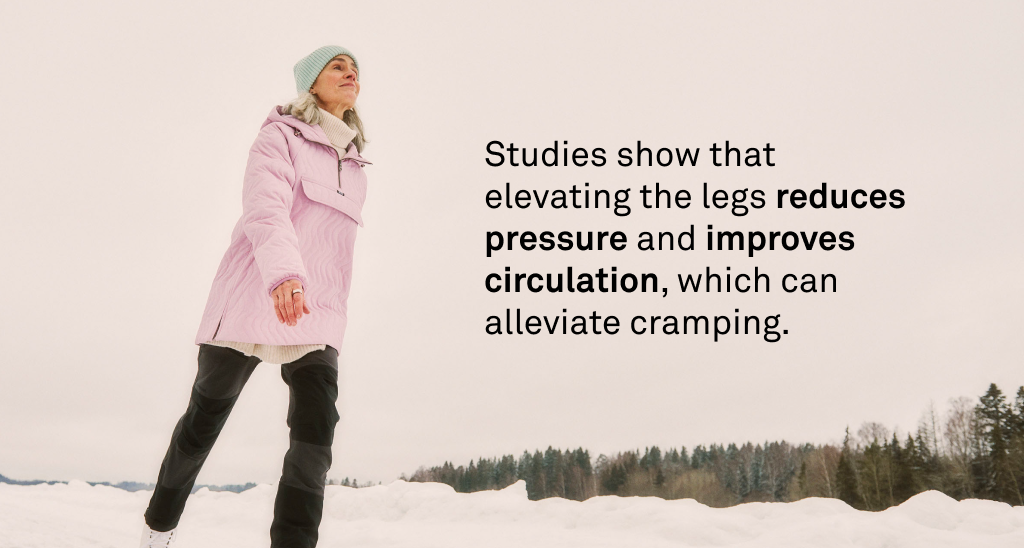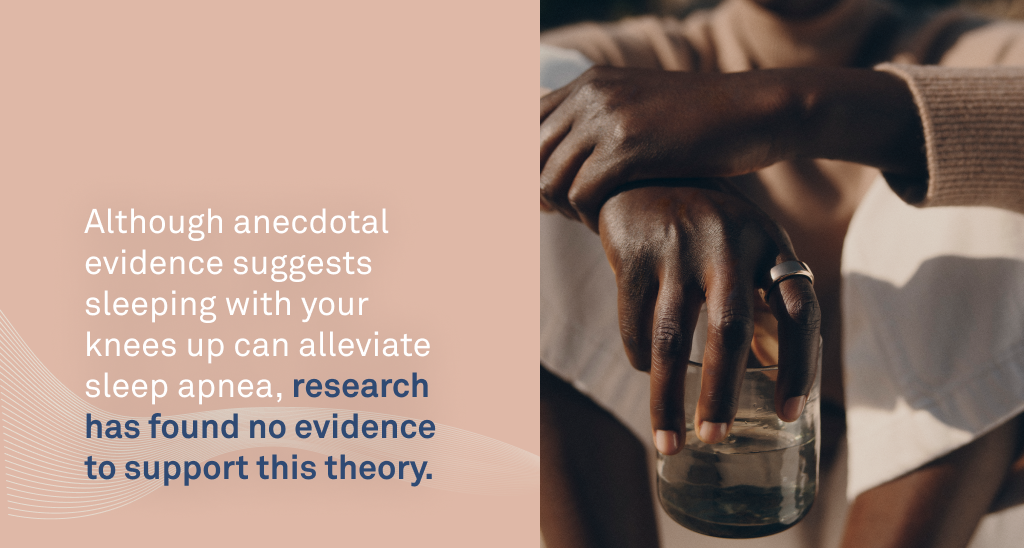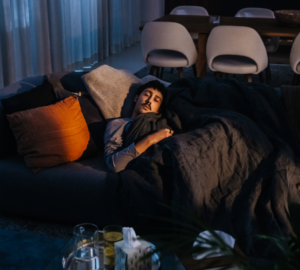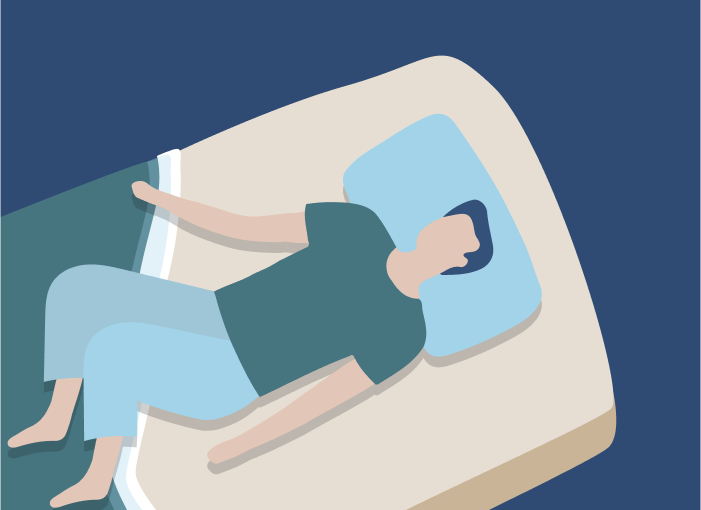- Why do I sleep with my knees up? This go-to sleeping position can be beneficial, offering less pressure on the lower back, improved circulation, and better spinal alignment. It may also help prevent conditions like edema and deep vein thrombosis.
- Despite the benefits, this position can have drawbacks, such as worsening sleep apnea or restless leg syndrome. It’s important to assess on a case-by-case basis and consult a healthcare provider if concerned.
- Oura members can use insights from the Oura App to track how different sleeping positions affect their sleep stages, Sleep Score, and overall sleep quality, helping them optimize their sleep habits.
Everyone has a preferred sleep style — some people are back, stomach, or side sleepers, others like to do their best starfish impression, and some favor more unusual positions.
While Oura won’t tell you to sleep one way or the other, members can use the insightful data generated to test and understand how different styles influence their sleep stages and Sleep Score.
If your go-to sleeping position is a little wackier — like sleeping on your back with your knees bent toward your chest — you may be wondering if it’s a cause for concern. But it’s more common than you might think.
Why Do I Sleep with My Knees Up?
There are many reasons why someone might sleep with their knees up, ranging from sleeping disorders to simply being a way to get better sleep.
The reason you sleep with your knees up is unique to you, but here are three possible explanations:
It May Be Your Default Sleeping Position
Sleeping with your knees up may alarm your sleeping partner, but the simplest explanation is that it’s the most comfortable position for your legs or back.
Even if you fall asleep in a different position, your body may default to this one in the middle of the night to relieve discomfort.
For example, if you suffer from lower back pain, you might find that sleeping with your legs straight alters the natural curve of your spine, causing pain. Elevating your knees decreases the pressure on your back, providing relief.
Alternatively, you may enjoy sleeping in the fetal position and mimic this sleep posture while lying on your back.
It May Be a Way to Deal with Leg Cramps
Whether you wear high heels, walk a lot, spend most of the day on your feet, or hit the gym regularly, your legs do a lot of work. Tension in the legs can lead to soreness and cramping when you go to bed at night.
Side sleepers may bend their knees into the fetal position to help alleviate their leg cramps, while back sleepers might also pull their knees into their chest — resulting in the knees-up position.
Sleeping with your legs bent may help to relieve leg cramps since studies show that elevating the legs reduces pressure and improves circulation, which can alleviate cramping.
You May Have a Medical Condition
In some cases, sleeping with your knees up may be a symptom of other health conditions.
For example, a person with periodic limb movement disorder (PLMD) or restless leg syndrome (RLS) may sleep with their knees up as a result of muscle contractions or to alleviate the discomfort these conditions cause.
| Member Tip: Oura tracks your nighttime movements so you can be aware of any tossing and turning that might indicate restless sleep. |
Alternatively, you may have a problem in your back or legs that causes discomfort, such as a slipped disc or trapped sciatic nerve.
The Benefits of Sleeping with Your Knees Raised

It may make you look like a dead bug, but there might actually be some benefits to sleeping with your knees up.
Less Pressure on the Lower Back
Research indicates that back sleepers who sleep with their legs straight experience more pressure in the lower back.
Those who sleep with their knees bent change the position of their pelvis, which lengthens the lower back and creates more space between the vertebrae.
This releases pressure on the lower back and spine, helping to alleviate pain and discomfort.
Improved Circulation
Most of the time, your legs are below your heart, and your body has to work against gravity to pump blood back up from your legs and feet.
Elevating your legs reverses the gravitational pull, making it easier for stale blood to flow back to the heart and lungs and be replenished with fresh oxygen.
Improving the blood flow in your legs can help reduce swelling and prevent blood clots. If you have an injury in your leg, reducing the swelling by elevating your legs at night may help you recover faster.
It also helps to drain lymph, the liquid that keeps your body’s fluids balanced and strengthens your immune system.
Since lymph isn’t pumped around the body by the heart, regularly elevating your legs can help keep your cells and tissues healthy — which is why many yoga poses involve getting upside down.
Optimal Spinal Alignment
Most people’s spines have a natural “S” shape with three curves (although this can be altered by conditions like scoliosis).
Resting in a flat position may cause tension and put undue strain on this natural curvature, causing discomfort and pain and putting your spine under unnecessary stress.
Sleeping with your knees up is one way to relieve this pressure by improving your spinal alignment.
It May Help Prevent Medical Conditions
Everyday activities wear the body down, resulting in sore legs, tiredness, and poor blood circulation. If the circulation in your legs becomes too sluggish, it can result in pain, swelling, and even blood clots.
Regularly elevating your legs can help prevent conditions such as edema (swollen feet and ankles), sciatica, and deep vein thrombosis.
Drawbacks of Sleeping with Your Knees Up
Despite the benefits of sleeping with your knees up, it can also come with some drawbacks.
For example, when sleeping on your back, your airways can narrow or become blocked, which may lead to snoring or aggravate symptoms of obstructive sleep apnea.
Although anecdotal evidence suggests sleeping with your knees up can alleviate sleep apnea, research has found no evidence to support this theory.
| Member Tip: Blood Oxygen Sensing at night can alert you to any breathing disturbances you may have. If this occurs, you can experiment with your sleeping position to see if that improves it. |

Sleeping with your knees up could also worsen sleep disorders such as RLS. Some people with RLS may find it helpful to elevate their legs when sleeping, but others might find it induces cramping in the legs and feet.
While sleeping with your knees up may be beneficial for some, it could cause problems for others, so it can only be assessed on a case-by-case basis.
With so many different possible causes and effects, it’s best to speak with your healthcare provider if you’re concerned — especially if you have pre-existing conditions.
Tips for Sleeping More Comfortably with Your Legs Raised
If you want to make sleeping with your knees up more comfortable, try elevating your legs with a support.
For example, a body pillow or knee pillow (or even just a normal pillow) can elevate your legs and improve circulation while allowing your body to relax.
If you try this option, make sure you use a thick, firm pillow because soft, downy cushions won’t hold your body weight well.
Alternatively, you could try a mattress raiser — a wedge-shaped piece of foam that you can place under the end of your mattress to elevate your legs.
If you really want to commit to sleeping with your legs raised, you could invest in an adjustable bed. This will allow you to support your legs while you sleep without the hassle of readjusting pillows all night.
As a bonus, many adjustable beds come with additional features to help you get a good night’s sleep, such as massages, music, and relaxing lights.
READ MORE: How to Choose the Best Bedding for a Better Night’s Sleep
Sleeping with Your Knees Up Is (Probably) Harmless
It might look a little odd, but in most cases, sleeping with your knees up is harmless and may simply be the most comfortable sleeping position for your body.
Picking the best sleep position for you depends on how you’re most comfortable in bed and how you feel when you wake up the next day. However, if you have any concerns about sleeping with your knees up, talk to your doctor.
| Member Tip: Use Oura to track your sleep cycles, including Deep Sleep, Light Sleep, and REM Sleep, which can show you if something is interrupting your sleep. You can then investigate to find the root cause. |
RELATED: 8 Popular Sleeping Positions & What They Mean for Your Health





